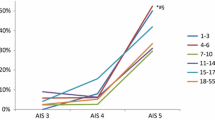Summary
The authors analysed a series of 111 adult patients admitted to the Department of Neurosurgery, Medical University of Łódź directly after trauma with initial GCS of 3 points. 74% of them had intracranial haematoma, mainly subdural, and were treated surgically within the first 3 hours after trauma. 8 patients had no abnormalities on CT scans.
99 (89%) patients died 2 to 30 days after injury, 8 (7%) survived in a vegetative state, and only in 4 (4%) was a satisfactory result noted, but 2 of them had a stable neurological deficit. 3 of these 4 patients had epidural haematomas and 1 had not abnormalities on repeated CT examinations.
We conclude, that among patients with GCS of 3 on admission, only those without major CT abnormalities or with epidural haematoma have a chance of survival. Cases with cerebral leasions on the initial CT examination have an invariably bad prognosis. They could be taken into account as a potential organ donor from the very moment of admission, but only after cerebral circulatory arrest occured and brain death has been proved according to internationally accepted standarts.
Similar content being viewed by others
References
Andrews BT, Pitts LH (1991) Functional recovery after traumatic transtentorial herniation. Neurosurgery 29: 227–231
Bouma GJ, Muizelaar JP, Stringer WA, Choi SC, Fatouros P, Young HF (1992) Ultra-early evaluation of regional cerebral blood flow in severely head-injuries patients using xenon-enhanced computerized tomography. J Neurosurgr 77: 360–368
Chan KH, Dearden NM, Miller JD, Andrews PJ, Midgley S (1993) Multimodality monitoring as a guide to treatment of intracranial hypertension after severe brain injury. Neurosurgery 32: 547–553
Cooper PR (1992) Delayed traumatic intracerebral haemorrhage. Neurosurg Clin North Am 3: 659–665
Haselberger K, Pucher R, Auer LM (1988) Prognosis after acute subdural or epidural haemorrhage. Acta Neurochir (Wien) 90: 111–116
Jennett B, Bond M (1975) Assessment of outcome after severe brain damage. A practical scale. Lancet 1: 480–484
Kotwica Z, Balcewicz L, Jagodziński Z (1990) Head injuries coexistent with fractures of pelivic or lower extremities bones — early or delayed osteosynthesis. Acta Neurochir (Wien) 102: 19–21
Kotwica Z, Breziński J (1990) Head injuries complicated by chest trauma — a review of 50 consecutive patients. Acta Neurochir (Wien) 103: 109–111
Kotwica Z, Brzeziński J (1993) Acute subdural haematoma in adults: an analysis of outcome in comatose patients. Acta Neurochir (Wien) 121: 95–99
Langfitt TW, Gennarelli TA (1992) Can the outcome from head injury be improved? J Neurosurg 56: 19–25
Lieh-Lai MW, Theodorou AA, Sarnaik AP, Meert KL, Moylan PM, Canady AI (1992) Limitations for the Glasgow Coma Scale in predicting outcome in children with traumatic brain injury. J Pediatr 120: 195–199
Luerssen TG, Klauber MR, Marshall LF (1988) Outcome from head injury related to patient's age. J Neurosurg 68: 409–416
McGraw CP, Howard G (1983) Effect of mannitol on increased intracranial pressure. Neurosurgery 13; 269–271
Mendelow AD, Teasdale GM, Russell T, Flood J, Patterson J, Murray GD (1985) Effect of mannitol on cerebral blood flow and cerebral perfusion pressure in human head injury. J Neurosurg 63: 43–48
Michaud LJ, Rivara FP, Grady MS, Reay DT (1992) Predictors of survival and severity of disability after severe brain injury in children. Neurosurgery 31: 254–264
Schmoker JD, Zhuang J, Shackford SR (1992) Haemorrhagic hypotension after brain injury causes an early and sustained reduction in cerebral oxygen delivery despite normalization of systemic oxygen delivery. J Trauma 32: 714–720
Zhuang J, Schmoker JD, Shackford SR, Pietropaoli JA (1992) Focal brain injury results in severe cerebral ischaemia despite maintenance of cerebral perfusion pressure. J Trauma 33: 83–88
Teasdale G, Jennett B (1974) Assessment of coma and impaired consciousness. Lancet 2: 81–84
Unterberg A, Kiening K, Schmiedek P, Lanksch W (1993) Long-term observations of intracranial pressure after severe head injury. The phenomenon of secondary rise of intracranial pressure. Neurosurgery 32: 17–23
Wilberger JE, Harris M, Diamond DL (1991) Acute subdural haematoma: morbidity, mortality, and operative timing. J Neurosurg 74: 212–218
Author information
Authors and Affiliations
Rights and permissions
About this article
Cite this article
Kotwica, Z., Jakubowski, J.K. Head-injured adult patients with GCS of 3 on admission — Who have a chance to survive?. Acta neurochir 133, 56–59 (1995). https://doi.org/10.1007/BF01404948
Issue Date:
DOI: https://doi.org/10.1007/BF01404948



